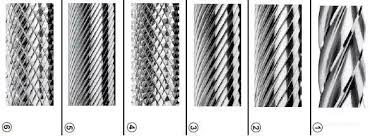Carbide rotary burr is made of high quality tungsten carbide material, also called tungsten steel rotary burr. Usually used with high speed electric grinder or wind tool. Can be used for a variety of work needs, such as processing cast iron, cast steel, carbon steel, alloy steel, stainless steel, hardened steel, copper and aluminum, etc.
1、Standard shape classification:
General carbide rotary burrs can be divided into the above 19 shapes, commonly used cylindrical, spherical, flame head shape, etc., domestic more letters such as A, B, C, etc. directly indicate each shape, foreign countries are usually abbreviated with the letters ZYA, KUD, RBF, etc.
There are also five tooth shapes used in the high speed rail industry:
2、Classification of cutting edge teeth:
Usually single-edged pattern tooth carbide rotary burrs are more suitable for soft non-ferrous metals, plastics, soft high tensile steel or hard wood processing operations, while cross-edged pattern is more suitable for hard materials to produce higher cutting performance, such as cast iron, cast steel, fiberglass plastic material made of workpiece grinding operations.
Each shape of the carbide rotary burrs can be selected according to the specific operational needs of the tooth shape of the blade, the general standard tooth shape can be referred to the above six. Among them, each tooth shape is applicable to:
① Tooth for aluminum – especially suitable for soft metals such as aluminum alloy, brass, magnesium, etc. Due to its wide tooth pitch, it is conducive to fast clean-up cutting;
② Coarse tooth pattern – recommended for soft materials such as bronze, tin, zinc, pure copper and other easily machinable materials;
③ Medium tooth pattern/standard tooth pattern – suitable for machining all kinds of steel (including tempered steel), cast steel and almost all metal materials. Good surface finish and relatively high machining efficiency for this profile;
④ Diamond tooth pattern – this tooth pattern is suitable for machining high alloy steel, stainless steel, magnesium alloy, gray cast iron and zirconium-nickel steel, effectively avoiding adverse phenomena caused by the crushing of chips during operation;
⑤ Dense tooth pattern – for finishing and other machining operations requiring high surface quality, especially for tempered steels with Rockwell hardness (HRC) of 66 or less;
⑥ Crossed tooth pattern – This tooth shape is suitable for all kinds of metal materials (including tempered steel and corrosion-resistant materials), and it is easy to control the operation with less vibration during processing.
There is another kind of chip-breaking tooth pattern, based on the single tooth file based on the choice of such tooth pattern, can be used for processing chip longer material, can be applied to ① ② ③ ⑤ file teeth.
3、Carbide rotary burr size selection:
The selection of carbide rotary burr size is mainly based on head diameter Dc and shank diameter D2, where the head blade diameter L2 and overall length L1 can be selected according to specific job requirements.
Standard carbide rotary burr: The shank diameter (D2) is mainly 3mm, 6mm, 8mm, 2.35mm is also available. The shank length is the common specification for operation.
Extended shank carbide rotary burr: The length of this kind of shank can be chosen according to the specific working condition, generally there are 75mm, 100mm, 150mm, 300mm, which is very suitable for processing difficult to contact or deeper area. The longer the shank is, the better it is, because too long will make it vibrate during the grinding operation and thus affect the working effect.
Micro carbide rotary burr: the head diameter of this kind of rotary burr is small, generally the shank diameter is 3mm. Because of its high concentricity, it is suitable for the trimming of station parts, etc.
4、Carbide rotary burr coating:
Generally speaking, there is no specific requirement for rotary burrs without plating treatment. Then the plating treatment of the rotary burr can mainly extend the service life of the tool, improve the cutting chip removal condition, have better heat resistance and anti-adhesive properties, and enhance the cutting power!
Post time: Jun-17-2023





